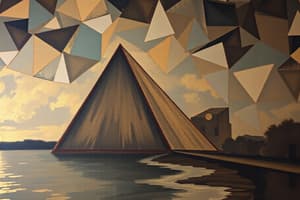Podcast
Questions and Answers
Which method of addition involves starting at one number, counting a second number, and then counting the total?
Which method of addition involves starting at one number, counting a second number, and then counting the total?
- Counting On (correct)
- Counting All
- Mental Math
- Using Objects
Which method of addition involves counting all the objects in the first set, then adding the objects in the second set?
Which method of addition involves counting all the objects in the first set, then adding the objects in the second set?
- Using Objects
- Mental Math
- Counting All (correct)
- Counting On
What aids children in visualizing addition and makes it more concrete?
What aids children in visualizing addition and makes it more concrete?
- Mental Math
- Counting On
- Using Objects (correct)
- Counting All
What method allows children to solve addition problems without relying on physical objects or written calculations?
What method allows children to solve addition problems without relying on physical objects or written calculations?
Why is understanding shapes, counting, and addition crucial for building a strong math foundation?
Why is understanding shapes, counting, and addition crucial for building a strong math foundation?
What is the main purpose of learning about shapes?
What is the main purpose of learning about shapes?
Which shape has all points equidistant from its center?
Which shape has all points equidistant from its center?
What does 'one-to-one correspondence' in counting refer to?
What does 'one-to-one correspondence' in counting refer to?
Which counting technique helps children grasp larger numbers quickly and efficiently?
Which counting technique helps children grasp larger numbers quickly and efficiently?
How does learning about shapes help us in real life?
How does learning about shapes help us in real life?
Study Notes
Exploring Math: Shapes, Counting, and Addition
Math is a universal language, helping us make sense of the world around us andmastering its basics opens up countless real-life applications. Let's dive into three fundamental concepts—shapes, counting, and addition—which lay the groundwork for a strong math foundation.
Shapes
Shapes are the building blocks of geometry and art. They teach us not only about symmetry and pattern recognition but also help us recognize objects in our environment.
- Named Shapes: A circle, square, rectangle, triangle, and pentagon are a few basic shapes that we learn as children. Each has its own unique defining characteristics, such as the circle having all points equidistant from its center.
- As we progress, we learn about supplementary and complementary angles, parallel and perpendicular lines, and the properties of polygons.
Counting
Counting is the most basic yet essential skill for young minds to grasp. It lays the foundation for our understanding of numbers and builds a strong foundation for more complex math topics.
- One-to-one Correspondence: This concept teaches children to match each item in a set to a corresponding number, making counting more meaningful and helping them understand the relationship between quantities and numbers.
- Counting by Fives, Tens, and Hundreds: Initially, children learn to count by ones. Soon, they learn to count by fives and tens to help them grasp larger numbers quickly and efficiently.
Addition
Addition is the mathematical operation of combining two numbers to produce a sum. It forms the basis of our understanding of arithmetic and the manipulation of numbers.
- Counting On: This method, also known as "counting up," involves starting at one number, counting a second number, and then counting the total.
- Counting All: This method, also known as "counting the total," involves counting all the objects in the first set, adding the objects in the second set, and then finding the total.
- Using Objects: Manipulatives, such as counting cubes or dot cards, help children visualize addition and make it more concrete.
- Mental Math: With practice, children can develop mental math strategies to solve addition problems without relying on physical objects or written calculations.
In summary, understanding shapes, counting, and addition is crucial for building a strong math foundation. These skills provide the building blocks for more complex mathematical concepts and help us make sense of the world around us. By encouraging children to explore math in a playful and engaging way, we can foster a lifelong love for learning and empower them to reach their full potential.
Studying That Suits You
Use AI to generate personalized quizzes and flashcards to suit your learning preferences.
Description
Dive into fundamental math concepts of shapes, counting, and addition to build a strong foundation in mathematics. Learn about geometric shapes, one-to-one correspondence, counting by fives, tens, and hundreds, various addition methods, and the importance of mental math strategies.




